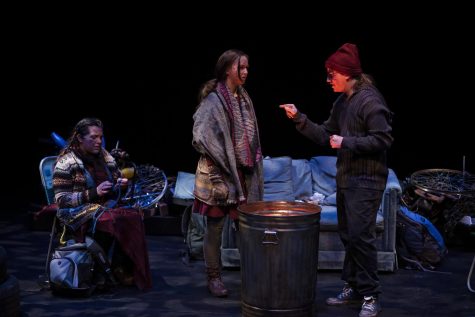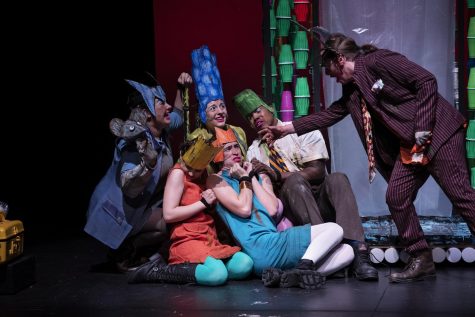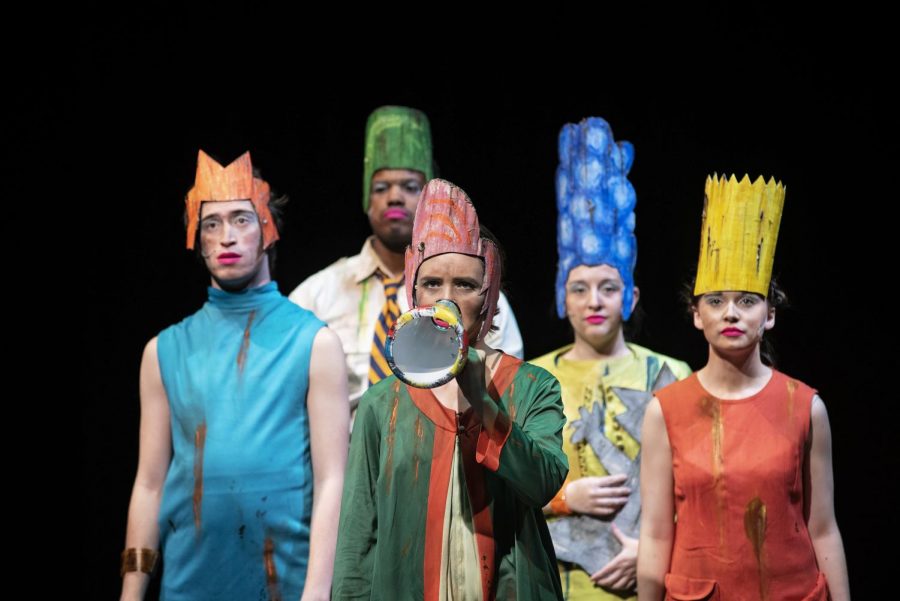Your donation will support the student journalists of Suffolk University. Your contribution will allow us to cover our annual website hosting costs.
PAO play humorously brings Simpsons family into odd post-apocalyptic setting
February 26, 2020
This past weekend, the Performing Arts Office (PAO) debuted its version of “Mr. Burns, a Post-Electric Play,” playing shows on Thursday, Friday and Saturday evening at the Modern Theatre.
The play, which is loosely based on the Simpsons episode “Cape Feare,” heavily depends on viewers understanding the plot of the episode before seeing the show. The cast addressed this need by screening the episode to the crowd before the play began.
Surrounded by leftover pieces of trash and debris from an apocalypse, a TV set showed the episode as patrons filed into the theater in the half hour between doors opening and the show starting. At first, this seemed to be a strange way to pass the time, as the playbill indicated that none of the characters nor the basic plot had anything to do with the Simpsons, except for the title.
This question was answered during the first act when the characters spent time trying to recall the plot of the episode to entertain each other. In their post-apocalyptic world, there is no electricity, and thus, no entertainment sources other than each other. (Not sure why books weren’t an option, but that’s another discussion).
In the second act, instead of trying to remember the episode, the characters are practicing the episode to perform it. This act takes place seven years after the first, and in those years many groups began touring their performances of Simpsons episodes to entertain others.
Besides the episodes, the group also performs commercials in between each scene. The funniest advertisement was a medley of pop songs from the early 2000’s, including “Toxic” by Britney Spears and “Allstar” by Smash Mouth, as well as the iconic 80’s classic “Never Gonna Give You Up” by Rick Astley.

It is assumed that the characters in act two are the same from earlier in the show, and we see tension grow between several characters who’ve returned from act one. Patrons also see the dangers of this world, as the end of act two ends suddenly with an intruder attacking the cast.
Act three is probably the strangest and most avant garde of all the acts. 75 years after the events of act two, the original characters we had gotten to know in the previous scenes are gone. In their place is a dramatic reenactment of the “Cape Feare” episode.
At this point, the play within the play has been misconstrued, as many stories do as they pass through generations. Unlike the original episode, in the reinterpreted version familiar characters from the Simpsons family die leaving Bart alone to fend for himself. Songs and music are also far more prevalent in the play, and there is heavy importance on the morals of life and death.
This third scene is where the play draws its name, as the “Post-Electric Play,” centered around the famous Simpsons character, Mr. Burns.
The set design of each act changes, implying the passage of time without necessarily being said. While the clumps of trash stay on the sides, the setting of the play changes from a trash yard, to a practice stage set with a make-shift living room, to the fake stage for the re-enactment.
The costuming was another visual element that helped indicate time passing as characters not only shed certain articles of clothing in favor for more age-appropriate pieces, but added dirt to their faces and clothing to show the struggles these characters went through living in their post-apocalyptic world. At the end of act three, some of the play-within-a-play’s actors donned black ribbons to represent that their characters had died and were now ghosts.

As noted in Suffolk Journal editor Morgan Hume’s preview of the show “PAO production will turn Modern Theatre into a post-apocalyptic world,” the three-act play has different directors for each act, as well as being a longer show than what the PAO is used to performing. However, instead of detracting from the play it showed the versatility, strength and skill each member of the cast and crew this play has. The students handled the show beautifully, and not once could you ever tell that this style of play differed from their normal repertoire.
This show was a farewell show for a few seniors, as actors Mollykate Rodenbush and Faith Quinn performed for their last time at the Modern Theatre.
Although it was perhaps one of the strangest plays performed over the past few years at Suffolk, if you did not attend “Mr. Burns, a Post-Electric Play,” you missed out on an electrifyingly brilliant performance.
